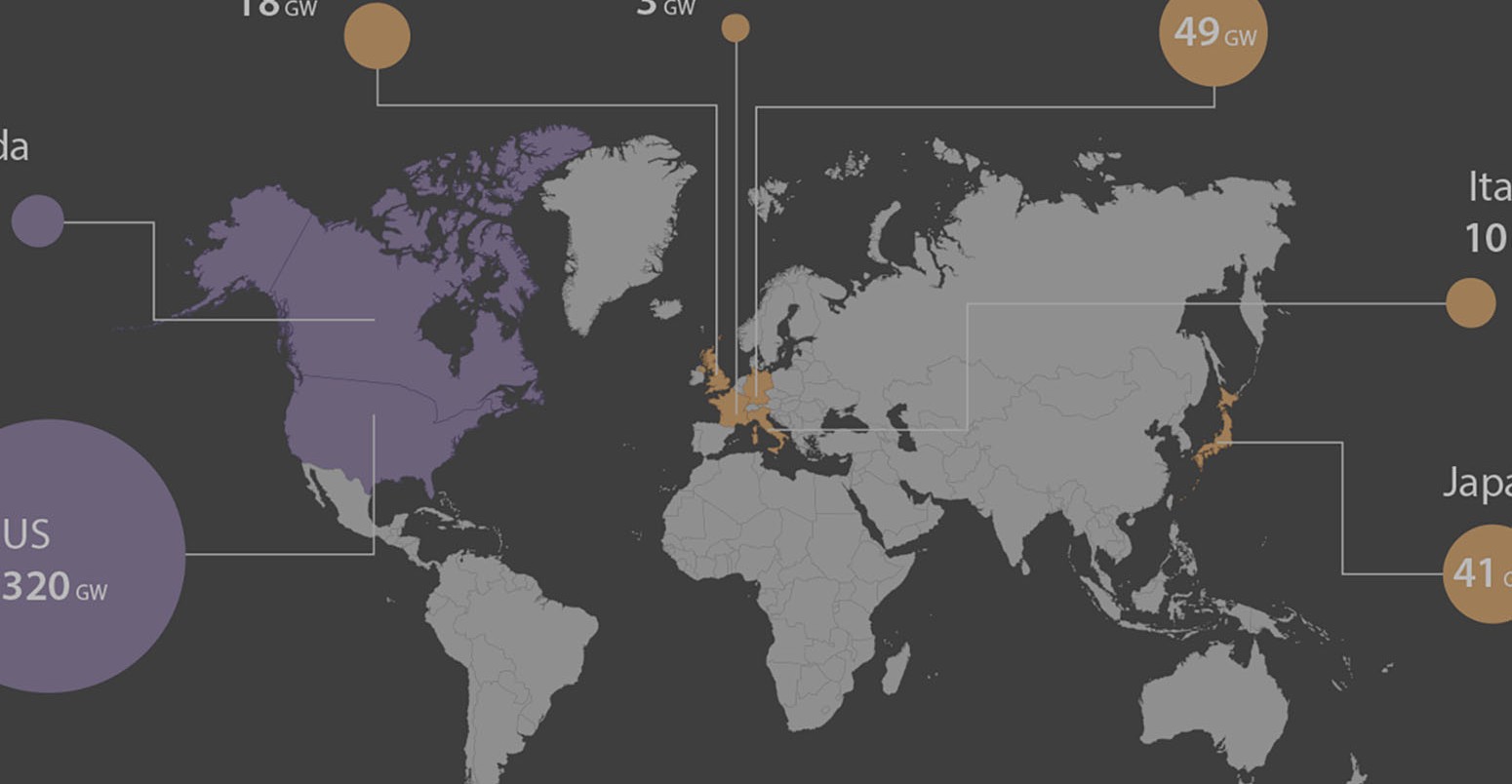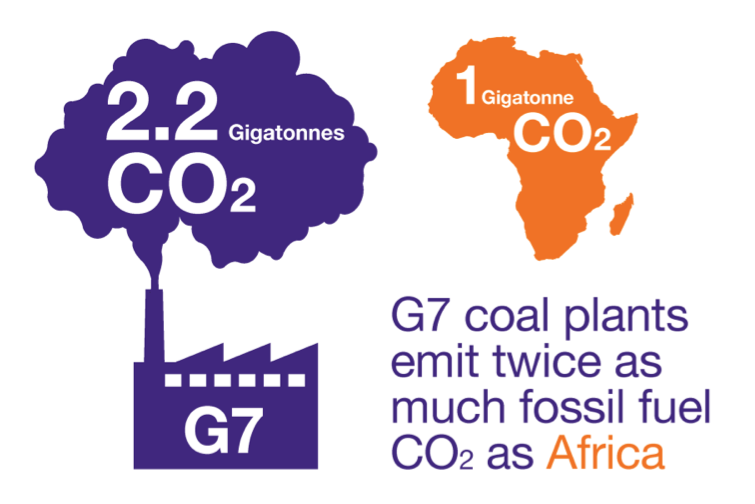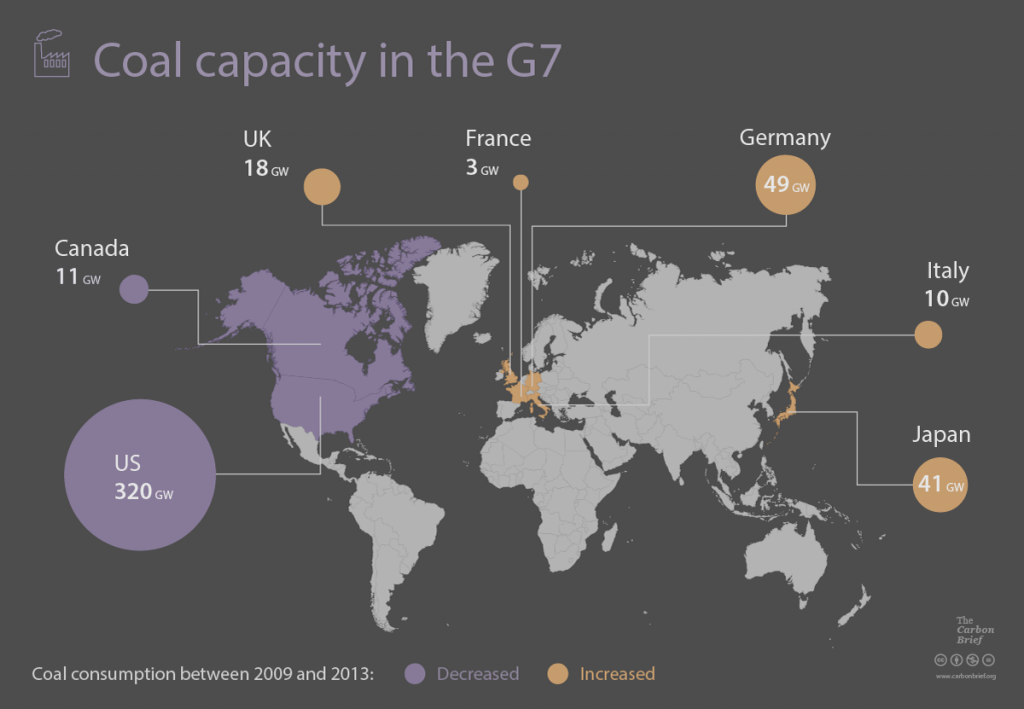
Tomorrow, leaders of the world’s seven largest economies will meet in Germany to discuss what they view to be the most important issues facing the world today.
High on their agenda will be climate change. With a new UN deal to curb emissions expected to be signed in December, it is already an issue that is uppermost in their minds, and all but Japan have formally submitted pledges to cut their greenhouse gases after 2020.
But while warm words about new actions are likely to abound, a new report from Oxfam, Let Them Eat Coal, has pointed out that all seven countries remain bound to coal – one of the most polluting fossil fuels.
According to the report, coal-fired power plants in the G7 countries are responsible for more than twice the total emissions of the 54 countries of Africa, and ten times more than the 48 least developed countries of the world.
Source: Oxfam 2015, Let Them Eat Coal
Using modelling by Berlin-based researchers at Climate Analytics, which assumes all governments implement their existing policies, the report says that emissions from G7 coal plants will cause $84bn per year in climate-related costs in Africa by the end of the century, based on the expected the costs resulting from adaptation and damage.
This is more than three times the $24bn the G7 delivered in bilateral aid to Africa in 2013.
Globally, the report says that G7 coal emissions will cost $450bn per year by the end of the century.
It’s worth noting that this is not exclusively a G7 problem. Another report released earlier this week revealed that $73bn in public finance was spent on supporting coal between 2007 and 2014. Almost half of this came from export credit agencies in OECD countries. Japan, a G7 country, was responsible for the largest portion, spending $20bn on coal in this eight-year period.
Using new research by E3G and our own research, Carbon Brief lays out the role that coal currently plays in each of the G7 countries.
Canada
- Size of coal fleet: 15 coal plants (11 gigawatts)
- Average age of coal fleet: 34 years
- Contribution of coal to total greenhouse gas (GHG) emissions in 2012: 9%*
On 1 July 2015, new federal regulations on coal will enter into force in Canada. The New Emissions Performance Standard will stop the construction of new unabated coal and limit the lifespan of existing plants.
Nonetheless, it allows the majority of Canada’s existing coal plants to continue functioning until they reach 50 years old, meaning the last of Canada’s coal plants will not be phased out until 2062.
Canada has pledged to reduce its emissions 30% on 2005 levels by 2030. It continues to expand its carbon-intensive exploitation of oil sands.
*Carbon Brief calculated coal’s share of G7 nations’ total emissions, using coal data from the US Energy Information Administration and emissions data from the EU Joint Research Centre’s Edgar database.
France
- Size of coal fleet: Only four coal plants (3GW) will remain after 2015, due to shutdowns as a result of EU air quality rules
- Average age of coal fleet: 32 years
- Contribution of coal to total GHG emissions in 2012: 8%
France currently has the smallest coal fleet in the G7, due to its high reliance on nuclear energy. However, the French government is a key stakeholder in energy companies EDF and Engie, which together held a coal fleet responsible for around 150 megatonnes of emissions in 2013.
France is soon expected to pass an Energy Transition Law, which is likely to set targets to reduce the share of nuclear in the energy mix from 75 to 50% by 2025, as well as reduce fossil fuel use 30% by 2030 on 2012 levels (although it faced pushback from the Senate in March, and does not explicitly address coal). To compensate, it will also boost renewables and cut overall energy demand in half by 2050 on 2012 levels.
France is subject to the EU’s target to reduce emissions 40% by 2030 on 1990 levels, which it has submitted to the UN as part of the forthcoming 2015 climate deal.
Germany
- Size of coal fleet: 49GW
- Average age of coal fleet: 30 years
- Contribution of coal to total GHG emissions in 2012: 32%
Germany has embarked on an ambitious transformation of its energy system, yet coal has proved a thorn in the side of plans to reduce emissions 40% by 2020, compared to 1990 levels. Together, hard coal and lignite were responsible for around 44% of Germany’s electricity mix in 2014.
Germany’s use of coal has increased since 2009, as the government has moved forward with plans to phase out nuclear by 2022. The German government says it cannot phase out coal and nuclear at the same time. It has promised to provide 80% of electricity consumption through renewables by 2050.
To ensure that it meets its 40% target, the German government has proposed a controversial new law, as yet unfinalised, aimed at reducing emissions by an additional 16Mt by 2020 by imposing a levy on older coal plants.
Italy
- Size of coal fleet: 10GW
- Average age of coal fleet: 37 years
- Contribution of coal to total GHG emissions in 2012: 12%
Italy has the smallest coal fleet in the G7 after France, and the share of coal in Italy’s energy mix dropped from 17 to 15% in 2013.
But the drop was more down to market forces than intervention from the government, the report says. In Italy, there is no firm policy in place to discourage coal, while its leaders have permitted new plants as recently as 2010, as well as subsidising individual plants.
70% of Italy’s coal capacity is owned by ENEL, a state-controlled energy company, which has announced a renewables push in a bid to go carbon neutral by 2050. It plans to close 23 fossil fuel plants by 2019, though only three of these are coal plants. They are also the oldest and smallest, and so will barely impact Italy’s coal portfolio in the short term, the report says.
Also part of the EU, Italy is subject to the bloc’s goal to reduce emissions 40% by 2030 on 1990 levels.
Japan
- Size of coal fleet: More than 60 plants (41GW)
- Average age of coal fleet: 24 years
- Contribution of coal to total GHG emissions in 2012: 29%
In the wake of the Fukushima disaster, Japan switched off its nuclear energy supply, leading to a dramatic increase in coal use.
The government has since been encouraging coal use through cutting red tape and providing subsidies to the industry, the report says. Japan has also prompted outrage through its use of climate finance to fund coal plants in Indonesia, India and Bangladesh.
Japan has 52 new plants in the pipeline, which would almost double its existing fleet.
Japan has proposed an emissions reductions target of 26% below 2013 levels by 2030 – a goal that has been criticised as unambitious and unrealistic, considering its reliance on restarting nuclear.
UK
- Size of coal fleet: 10 (18GW)
- Average age of coal fleet: 41 years
- Contribution of coal to total GHG emissions in 2012: 25%
In 2014, coal was responsible for around 29% of the UK’s electricity generation, down from 36% the previous year, falling to a low point last seen when the industrial revolution kicked off in the 1850s.
Ahead of the general election, all three of the main party leaders agreed to phase out unabated coal – a target without a deadline – and has already banned new unabated coal. A top-up carbon tax in the UK adds additional financial pressure to polluting coal plants. This doubled in April, from £9.54 to £18.08 per tonne of carbon dioxide (CO2). Citing rising costs and the impact of environmental legislation, the SSE Ferrybridge plant announced its closure in May.
According to the report, however, the future of emissions pricing is unclear, and is not guaranteed to bring about the promised end to coal generation.
The UK is legally obliged to reduce emissions 80% by 2050 compared to 1990 levels, thanks to its 2008 Climate Change Act.
USA
- Size of coal fleet: 320GW
- Average age of coal fleet: 45 years
- Contribution of coal to total GHG emissions in 2012: 26%
The US is the second largest coal consumer in the world after China. Coal accounts for about 77% of the CO2 emissions from the US electricity sector, although it represents only about 39% of the electricity generated.
In June 2014, President Barack Obama issued his Clean Power Plan, an Environmental Protection Agency rule intended to reduce power sector emissions by 30% on 2005 levels by 2030. However, the plan faces a raft of legal challenges by those in favour of coal.
There has also been a concerted grassroots movement to end coal in the US. With the Sierra Club at the helm, campaigners have contributed to the closure or scheduled retirement of 189 existing plants since 2010 – one third of the size of the US fleet.
The US plans to reduce its emissions by 26-28% on 2005 levels by 2030.



